Abstract
In Italy, a large part of the buildings classified as historical–artistic heritage is in a state of degradation and requires urgent interventions. Among the needs, a reduction in the high energy consumption and an improvement of the indoor comfort are mandatory. The case study of the “Ex Institute of Zoology of Palermo” shows how it is possible to achieve a reduction in energy consumption and preserve the building’s historicity through the estimation of energy loads and the subsequent processing. To quantify the energy savings of the structure, it was necessary to follow a few steps, namely an inspection of the building and an evaluation of its consumption. To elaborate a correct energy analysis, the thermal conductance was calculated by considering measurements over a period of 60 days and proceeding with the calculation of the transmittance. The resulting data are imported in the energy model developed with the TERMUS BIM software. In the case study, a potential energy saving equal to 35% of the current energy consumption can be avoided by replacing the lamps with LED ones, installing photovoltaic panels, replacing the heat pumps with a centralized system and the current fixtures with double thermal break fixtures. These interventions are implemented in compliance with the architectural peculiarities.
1. Introduction
When energy resources are limited, energy saving becomes the first mandatory technique to be implemented [1]. In fact, the current methods of production and use of energy often appear to be very inadequate in comparison to the state of the art. Within the complex Italian scenario, energy consumption in the historic building sector deserves particular interest [2,3,4]. Many aged buildings in Italy are part of the historic–artistic heritage. However, a relevant part of them is affected by a state of degradation; thus, they require restoration and maintenance interventions, with the possibility to reduce the energy consumption and improve the indoor environmental quality [5,6,7].
Indeed, the energy consumption of historic buildings should be limited. In a time of energy crisis, the improvement of the energy performance of these buildings becomes even more attractive also from an economic point of view. Heritage buildings are affected by high energy consumption due to outdated construction features and inefficient systems. Replacing them with innovative technologies may lead to a reduction in energy demand. Furthermore, the energy efficiency of these buildings can be further increased if the energy demand is properly managed. A reduction in the energy demand of historic buildings can free up resources for more sustainable uses in other sectors and foster greater energy resilience. The issue of energy efficiency is a fundamental issue on which European policies have heavily invested [8,9]. The European Union (EU) aims at the targets of decarbonization and transition to “clean” energy as well as energy union, issuing several directives eventually transposed both at the national level in Italy (IT) and in the member states [10]. The research and innovation program of the European Union, Horizon 2020, has financed numerous projects aimed at improving the energy efficiency in many civil and industrial sectors, wherein energy efficiency interventions have been carried out in recent years using various techniques, involving historical data estimation and sensor installation [11]. Alongside interventions in the public sectors, several activities, on the other hand, specifically promote energy optimization in sites belonging to cultural heritage. These projects include the search for innovative technological solutions, the implementation of energy-saving measures and the improvement of the energy performance of historic buildings [12]. The European Union’s LIFE program supports projects that promote environmental conservation and sustainability. There have been LIFE projects that have experimented with energy efficiency interventions in cultural sites, with the aim of reducing energy consumption and CO2 emissions, for example through the installation of low-energy-consumption lighting systems and thermal insulation of historic buildings [13]. Following the approval of the “Next Generation EU” to address the economic crisis caused by the COVID-19 pandemic and to promote the country’s economic recovery, innovation and resilience, the Italian government approved the “National Recovery and Resilience Plan” (PNRR). In particular, in component 3-Measure 1 of Mission 2 of the PNRR, the implementation of a program is proposed to improve the efficiency and safety of the public building heritage, with interventions concerning in particular schools and judicial citadels. In order to achieve the complete decarbonization of the civil sector foreseen for 2050, it is necessary to promote the rapid energy conversion of the real estate assets, favoring deep redevelopments and the transformation into “nearly zero energy buildings” (nZEBs), in line with the strategy for the energy requalification of the national real estate assets [14,15]. Each government, including the Italian one, has provided tax incentives (eco-bonuses, earthquake bonuses, house bonuses, facade bonuses, superecobonuses, etc.) [16] and special funds (PREPAC, etc.) in order to reduce the building energy consumption. For the redevelopment of historic structures, it is mandatory to find a balance between the requirement of energy efficiency and thermal comfort, and the preservation of the aesthetic character. This approach influences the choice of possible interventions such as the insulation of the external walls, the updating of the systems and the installation of photovoltaic panels. The improvement of the energy performance of buildings should be encouraged, although every choice should be weighted. In Italy, the current law regulating this aspect is the “Code of Cultural Heritage and Landscape” [17].
To ensure protection, a ministry of Cultural Heritage and Activities has been delegated to supervise and decide what interventions can be carried out. The opinion of the ministry is always necessary for any kind of intervention.
Regarding buildings, many studies have been carried out to make public and private buildings more efficient.
Curto D. et al., carried out a work on the university dormitory in University of Palermo. They demonstrated how to improve energy efficiency in a university building through the study of load profiles. In this way, it is possible to significantly reduce energy consumption. The results showed that it can be reduced by 50% or more [18].
Piotr Michalak et al., carried out an assessment of energy performance using correlation models between the number of users and the heated volume of buildings in Poland. Analyzing a dataset containing 29 multi-family building audits, the values of the buildings before and after the planned renovation were compared. The energy for domestic hot water depends on the building inhabitants, as well as the heating energy from the users and volume of the building [19].
Battista G. and De Lieto E. performed a retrofit operation on a historic building in a restricted area of Rome, using a commercial tool called RETScreen. This software was used to build a reliable and accurate model of energy consumption and consequently predict the energy savings [20].
In a work on the improvement of energy efficiency, Vallati A. and Di Matteo M. evaluated through models the potential energy consumption in historic buildings. The study neglects the elements of the architectural language of the past, and therefore can cause an error in the interpretation of the results. It is therefore desirable that the energy model should be integrated with a calculation of the thermal conductance through the use of a heat flow meter and a correct processing in an Excel sheet [21].
Sugar V. et al., developed a study on the various types of energy efficiency in relation to the different architectural styles. The results show that, based on the footprint area and architectural style, it is possible to accurately estimate the heating energy needs of a building [22]. Coelho G. B. A. and Henriques F. M. A. studied a set of retrofit measures for historic buildings to improve their indoor climate in terms of conservation metrics considering climate change. Their considerations make it possible to evaluate the interventions in order to analyze the objective of the energy retrofit before the renovation [23].
For the protection of Italian historical buildings, the “Guidelines for the improvement of energy efficiency in cultural heritage” have been prepared by the Ministry of Cultural Heritage and Activities and Tourism. In this research work, every decision has been assumed in continuous dialogue and intradisciplinary reconciliation. This article focuses on the energy efficiency of the former Institute of Zoology and Comparative Anatomy in Palermo, currently used as headquarters of the S.T.E.B.I.C.E.F. of D.I.S.T.E.M and of the “Pietro Doderlein” Museum of Zoology. The work developed in this article is an example that shows how attractive the replication of these interventions on other public buildings could be.
2. Materials and Methods
2.1. The Place of the Museum and the Institute
The “Ex Institute of Zoology and Comparative Anatomy” is part of a group of six historic buildings located in “Via Archirafi”. This complex was built at the beginning of the 1900s in the land that was called “Vigna del Gallo” at that time. The buildings were designed by a team of architects and engineers led by Ernesto Basile. The famous “Botanical Garden”, one of the most important in Italy, is in the same area.
The university buildings in Via Archirafi compose one of the three university areas in Palermo together with the “Parco D’Orleans Campus” and the “Paolo Giaccone Campus”.
Figure 1 identifies the historic buildings located in the historic headquarters of via Archirafi and marks the building considered as case study.
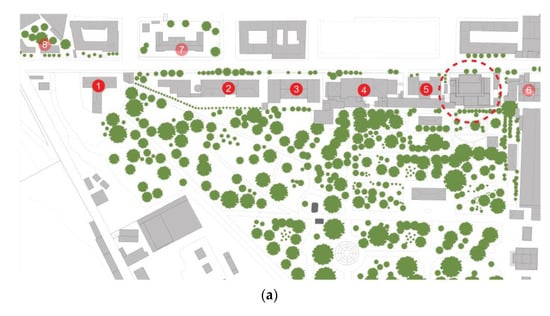
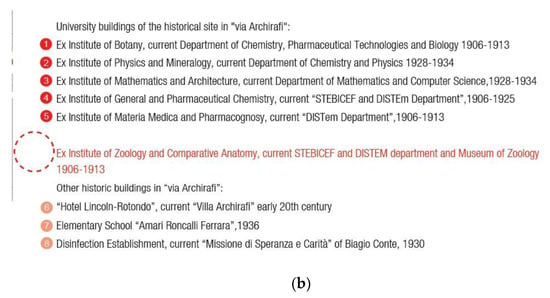
Figure 1.
(a,b) Identification of historic buildings located in the historic headquarters in via Archirafi.
The initial structure of the Ex Institute of Comparative Zoology and Anatomy was different from the current one. The building body was initially made up of an open courtyard building, developed over two levels consisting of a large assembly hall, a large room (for the zoology museum) and two lateral bodies (for laboratories). The roof was previously a sloping gable roof for the great hall, the corridors and the museum, but it was later modified into a single-pitched one. The main front of the museum was characterized by a tree-lined entrance courtyard enclosed between the two wings of the building. In the 1950s, Prof. Giuseppe Reverberi (Director of the Institute from 1948 to 1971) felt the necessity to expand the structure due to the necessity to convert the building from a museum to a university institute. Indeed, the existing equipment and the layout of the premises were ill-adapted to experimental research, as required by modern naturalistic guidelines.
The project for the construction of the two additional buildings adjacent to the great hall was conducted by Eng. Rosselli and Cocciola of the Civil Engineering Office of Palermo. The works began in 1952 and ended in 1953. In the same year, a cellar floor was built, initially used as a darkroom and workshop. A new additional body was built in 1962 in the space enclosed between the projecting wings of the institute, where there was previously a tree-lined courtyard. This new section was built in two stages: the works for the part adjacent to the left corridor began in 1962 and ended in 1964; after that, in 1965 it was decided to saturate the remaining space by completing and standardizing the new facade, consisting of a new access.
In 1966, a new low body was built on the rear front, causing the demolition of most of the separation gate with the Botanical Garden. In 1968, following the assignment of the chair of Comparative Anatomy to Prof. Monroy, it was decided to separate it from the two chairs of Zoology and Comparative Anatomy; the latter was moved to another location and since then the Institute of Via Archirafi has been the seat of the only chair of Zoology. In 1970, two corridors perpendicular to the existing one were built on the second floor. The caretakers’ accommodation was annexed to the building in 1972; finally, in 1993 the lift was installed and the staircase in the left side corridor was extended up to the second floor, involving the demolition of a part of the pitched roof in that corridor.
On 1 January 1997, following the Decree n° 3020 of 17 December 1996 of the Academic Senate, the Institute of Zoology was transformed into the Department of Animal Biology. In 2013, the Department of Animal Biology was split into the Department of Biological, Chemical and Pharmaceutical Sciences and Technologies (STEBICEF) and the Department of Earth and Sea Science (DISTEM). Both departments continue to coexist in the same complex [23,24]. In the following Figure 2 and Figure 3 are shown the construction phases of the building and the main facade.
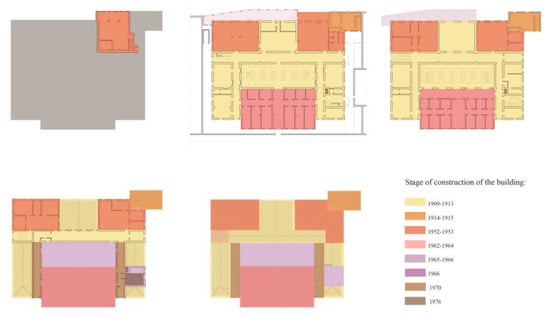
Figure 2.
Stages of construction of the parts of the building during the 1900s.
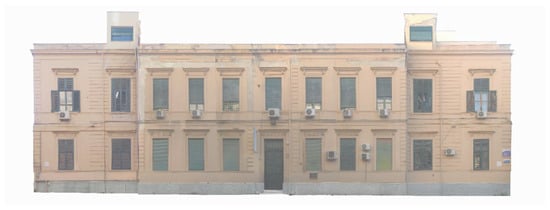
Figure 3.
The main facade of the building.
2.2. Research Method
The purpose of this study is to demonstrate that it is possible and convenient to make a historic university building more efficient while respecting its historicity. The method used for the development of the project was extended from the study of the load profiles up to the choices of the interventions to be carried out in order to safeguard the aesthetics of the building. The aims of this study are the reduction in energy consumption and the identification of guidelines to facilitate future studies.
The first surveys considered the historical archival research to obtain data relating to the construction period of the individual parts of the building. This phase clarifies the stratigraphy of the walls and the exact period of construction. The second activity was the inspection of the building in order to obtain the dimensions of the rooms, the technical characteristics of the windows and ceilings, the type of lighting installed and the characteristics of the thermal and electrical systems. The data were collected by preparing technical data sheets for each room of the building. These data include the type of equipment, the installed power and switch-on time for each device.
Subsequently, the estimation of the corresponding energy demand of the utilities was carried out. Thanks to the cooperation of ENEA (which in Italy is the National Agency for New Technologies), a heat flow meter was installed in a classroom on the first floor of the building for the calculation of thermal conductance [24].
Following this preliminary study, adequately prepared forms were compiled and then processed in Excel for the calculation of energy consumption (performed through the TERMUS BIM software v.52.00f) of the STEBICEF/DISTEM/MUSEO departments, also including the consumption relating to the specific equipment used in the laboratory [25]. In Figure 4, the three departments are distinguished.

Figure 4.
Scheme of the distribution of the three departments that coexist in the complex.
2.3. Technical Description of the Building
The Ex-Institute of Zoology and Comparative Anatomy currently houses two university departments: Biological, Chemical and Pharmaceutical Sciences and Technologies (STEBICEF) and the Department of Earth and Sea Sciences (DISTEM) and the “Pietro Doderlein” Museum of Zoology, which is currently an important reference for the scientific community. The museum currently houses one of the largest collections in Italy, comprising more than 5000 specimens and exhibited in phytogenetic order. The building consists of three floors above ground and a basement. The STEBICEF is distributed between the ground floor, the first floor and the basement, whereas the DISTEM is distributed in a few rooms on the second floor. The distribution of the rooms is balanced between offices, laboratories and classrooms for frontal lessons. The Zoology Museum represents the beating heart of the institute, located in the central area of the building, and distributed in a single double-height room between the ground and first floors. The building envelope was built over several stages, which is why the central core of the building and the extensions prior to 1952 have a load-bearing masonry structure.
2.4. Characteristics of the Enclosure
The building envelope was built over several stages, which is why it is possible to identify two different structural types in the building.
The lower horizontal closure system is made up of load-bearing walls in calcarenite ashlars bonded with semi-hydraulic mortar. The foundations of the first nucleus of the building have a depth of 3 m and a width of 1 m, whereas for the other foundation walls a 2 m deep and 80 cm wide excavation was carried out. Mixed dry tuff stones with limestone were used for the construction of the crawl space.
The vertical closing system relating to the first nucleus of the building is made up of ashlars of “pietra d’Aspra”, with a thickness of 50 cm, while for the partitions the “terzaruole dell’Aspra” were used, that are typical Sicilian bricks with a thickness of 30 cm. About all the extensions after 1952, the framed system was used for the construction of brick walls joined together with lime mortar with a thickness of 30 cm.
The horizontal closure system relating to the first nucleus consists of floors made of double T-shaped iron beams 20 cm high, with vaults in ashlars of “pietra d’Aspra”.
Fake “litter” vaults with a slight concavity in the lower part were made with wattle and plaster mortar for the museum and the Aula Magna. Following the first expansion in 1953, brick and concrete floors were built.
The internal floors on the ground floor were made with an 8 cm thick layer of “matton pesto tercisato” and semi-hydraulic mortar on which a casting of at least one centimeter of cement was made in slabs on a suitable gravel substrate. Ordinary compression cement bricks over semi-hydraulic mortar were used upstairs. Following the first expansion in 1953, floors were made in “Perlato di Sicilia”, a marble extracted from Sicilian quarries.
The upper closing system for the pitched roofs of the great hall and the zoological museum is characterized by wooden grooves, chains, struts and purlins in pitch pine wood. For the museum, a two-pitch roof in “Marseillaise tiles” was used, recently replaced by a single pitch with corrugated sheet metal.
For the roofs built in a later period, brick and cement floors were used. The analysis of the deteriorations was carried out on the facade of the building facing via Archirafi. The prospectus is characterized by two types of walls built in two different periods, in particular, the two wings to the original nucleus, and the central one to the expansion of 1962–1966.
More than 27 different types of fixtures have been identified in the building, which can be grouped into three categories.
- Wooden fixtures: According to photographic evidence from 1935 and 1999, the building was formerly made up only of Swedish pine wood window fixtures, with pitch pine wood shutters or shutters painted with a layer of linseed oil slightly soiled, cleaned pumice putty and three coats of oil paint which were subsequently replaced or restored. They are currently partially present in the original nucleus of the building and on the façade on via Archirafi.
- PVC fixtures: It is believed that they were introduced after the lack of maintenance and removal of part of the wooden fixtures. Furthermore, as consequence of some internal modifications, many fixtures were resized and replaced with PVC fixtures painted green to bring them into line with the wooden fixtures.
- Aluminum fixtures: This type of frame was introduced to replace the damaged wooden fixtures, but maintaining the original design of the window, as can be seen in relation to the windows of the Aula Magna and block C.
2.5. Characteristics of the Systems
- Heating and cooling system: The building is equipped with a centralized heat pump system serving the “Pietro Doderlein” museum. The external unit is installed in the roof of the building. With regard to the university premises, split-type systems are installed in the classrooms and offices, connected to external units on the facades of the building. However, this solution did not consider the requirement of a protection and the aesthetic impact on the building facades. Five different types of splits have been identified (82 units in total) with the following rated power: 350, 450, 700 and 1400 Watt. For each area, an estimation of the load diagram was conducted, considering the intended uses of the premises. In the basement, the corridor on the top floor and in the museum are served 24 h a day for about six months a year by the air conditioning systems to guarantee a correct state of conservation of the study samples present in the building.
- Domestic hot water production system: 50 L and 10 L electric water heaters are used. This type of system can be found in the toilets, some laboratory classrooms and the animal house on the basement floor.
- Type of lighting fixtures: The lighting of the building appears to be almost efficient in the DISTEM department where, thanks to the renovations in 2004, all the fluorescent lamps were replaced with low-consumption LED lamps. Similarly, the exhibition hall of the museum is already equipped with LEDs for the lighting of the museum displays. However, most of the STEBICEF classrooms are currently enlightened by the fluorescent lamps, installed in 60 × 60 cm ceiling lights or by using 1.2 m or 1.8 m fluorescent tubes.
- Lifting systems: An elevator and a platform for the disabled are placed at the entrance of the department.
- Other equipment: the vocation of the building as a scientific university building implies the presence of classrooms for lectures and laboratories, in which high energy consumption equipment is used daily to conduct experiments. In order to consider all the energy consumption of the building’s users, research was carried out also on the various types of machinery found in the building. In detail, the rated power was annotated. Questionnaires were also created and submitted to the teachers in order to collect data on the typical usage time of the machinery in the Institute.
2.6. Load Profile
The estimation of the loads was performed through the census of the plants and laboratory machineries. The evaluations were made by acquiring data on the occupation of laboratories and offices by students and teachers. In Italy, a law regulates the periods in which the heating systems are turned on, dividing the country into climatic zones. Palermo is inserted in climate zone B [26]; therefore, heating is guaranteed from 1 December to 31 March. Furthermore, since the department is destined for scientific studies, the consumption of refrigerators, machinery and heating and cooling systems were evaluated. In particular, the heating and cooling plant is currently active 24 h a day for a period of 6 months; in the case of the zoology museum, the plant is active during the entire year [27]. Customizing modelling tools for recent buildings involves oversimplification, neglecting elements of the architectural language of the past, such as footings, cornices, portals, cornices and the shape of the windows; this affects the thermal results by underestimating the non-negligible thermal bridge effects, or by introducing errors in the interpretation of the results. Among the most significant intrinsic limitations are those related to heat and mass transfer processes. Furthermore, very often the collection of stratigraphic data can be difficult and various hypotheses must be made. The integration of the energy model must therefore be carried out through data collected on site. In this research work the on-site detection of thermal conductance was carried out by using the progressive average method in order to compare the values between actual performance and simulations.
2.7. Analysis of the Building Envelope: On-Site Detection of Thermal Conductance Using the Progressive Average Method
A thermal conductance test was carried out on the wall of the building corresponding to the addition of 1952–1953. The measurement of the thermal transmittance in situ with the heat flow meter is a standardized procedure applied to the opaque surfaces of a building. It is based on the analysis of the thermal flow that passes through the architectural structure as well as the internal and external surface temperatures (UNI EN 9869-1:2015) [28]. In the preliminary phase, an area of the building was identified far from heat sources, shafts and any thermal bridges for intermittent use; for this reason, the corridor on the second floor was chosen as a suitable place for the test. The analysis was carried out by placing two probes on the internal surface of the perimeter infill under investigation, and a second pair of probes outside the structure. These instruments, connected to an internal plate, are used to calculate the internal and external surface temperature (see Figure 5).
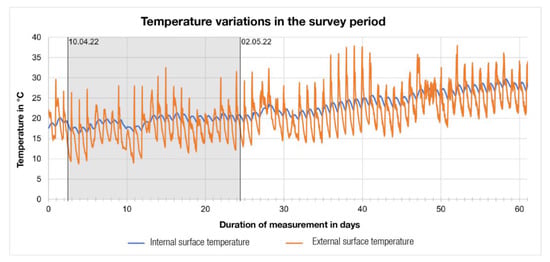
Figure 5.
Temperature variations in the survey period.
Data were collected for 17,636 steps per hour. In the analysis period, barring sporadic exceptions, the range of variation in the external surface temperature overlaps that of the internal surface temperature, as shown in the graph below. This circumstance has a very negative impact on the success of the test. The graph also shows a relative stability of the temperature (especially internal) before exceeding eight thousand readings. For this reason, subsequent data have been discarded. The data corresponding to the first days of the survey were also discarded, because the calculation of the conductance recorded excessive peaks, due to the overlap between the two temperature values. Taking these observations into account, 6336 steps were analyzed, corresponding to twenty-two days of measurements (since the measurements were recorded every five minutes). The conductance was calculated using the progressive average method (paragraph 7.1 of the UNI EN 9869-1:2015 standard). Considering the last calculation value, the conductance is Λ = 1.27 W m2·K −1 (R = 0.79 m2·K·W−1). Instead, calculating the average of the last twelve hours gives Λ = 1.29 W·m−2·K−1 (R = 0.78 m2·K·W−1). With reference to the verification conditions indicated at the end of standard paragraph 7.1:
- The measure lasted more than 72 h.
- The resistance calculated with reference to 24 h ago gives the same values as the resistance obtained considering all the data; without the approximation to the second decimal place, the deviation is 0.04% (0.97% if the resistance is calculated as the average of the last twelve hours); therefore, it is within the range ±5%.
- The strength obtained considering the first two-thirds of the test period is 0.65 m2·K·W−1 (0.64 m2·K·W−1 if the average of the last twelve hours is calculated), while when considering the last two-thirds of the test period it is 0.84 m2·K·W−1 (0.83 m2·K·W−1 with the average of the last twelve hours); the deviation is 22.5% (22.53% with the values calculated on the basis of the average of the last twelve hours of testing); therefore, it is clearly outside the ±5% range. In Figure 6 are shown the results obtained for thermal resistance measurements.
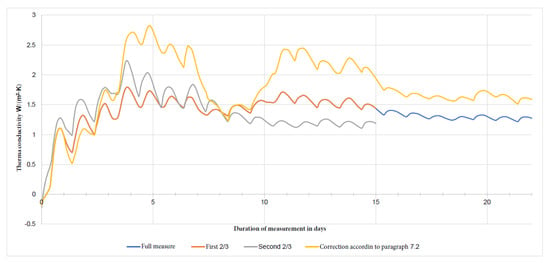 Figure 6. Measured values of thermal resistance.
Figure 6. Measured values of thermal resistance.
Following the corrective criterion, we obtain Λ = 1.59 W·m−2·K−1 (R = 0.63 m2·K·W−1). The R value is much smaller than the R = 0.86 m2·K·W−1 value (as the sum of the Rk terms). The deviation is equal to 26.33%, outside the range ±5% The conditions under letters “a”, “b” and “e” of the list in paragraph 7.2.3 are satisfied. As for “d”, the ±5% interval is always respected if these are calculated by considering the average of the results of the last twelve hours. Instead, if the final value is considered, only the comparison between the R-value at the end of the test and that of twenty-four hours earlier is respected.
However, since the test was not performed under optimal conditions, it is more appropriate to proceed with another step. If the above conditions are not satisfied, the test result is subject to a wider range of uncertainty; the optimal execution of the test error is between 14% and 28%. One of the possible causes that increase the error rate is the fluctuation of the internal temperature compared to the temperature difference between the two sides of the component. In this case, however, the error is mainly due to the fact that the change in outdoor temperature has deflected the direction of heat flow [29,30].
2.8. Load Estimation
The estimation of the loads was performed with the aid of the TERMUS-BIM software, creating the BIM model. The analysis is carried out starting from the climatic data of the place where the building is located, just entering the locality and the climatic zone. By compiling the properties of materials and the stratigraphy of the individual construction elements, the program allows you to identify the transmittance values and verify that they comply with the UNI EN ISO 13788 standard [31]. In Figure 7 is shown the BIM model of the building, and in Table 1 are listed the energy required, the thermal load and the CO2 emitted in one year.
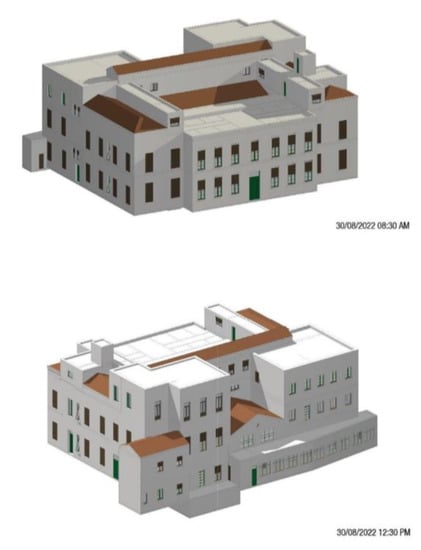
Figure 7.
BIM model of the building under study.

Table 1.
Thermal requirement of Ex Zoological Institute.
3. Results and Discussion
Energy Saving Measures
The theme of system adaptation represents one of the most delicate issues connected to architectural restoration. In particular, this type of intervention must take into account the new needs to be met in order to guarantee standards of well-being and functionality dictated by the vocation attributed to the historic buildings. The intervention program must be adequately calibrated to the needs of the historic building, limiting the interference on the pre-existing structure in compliance with the historical value, and assessing the compatibility of the intervention to be made. It is therefore important to underline how it is possible to significantly reduce energy consumption through interventions that make the building envelope and the use of systems efficient. Evidently, it is important that users are properly oriented toward energy saving practices. The new plant equipment must therefore interact positively with the building, correcting the harmful environmental conditions in order not to damage the building, and guaranteeing comfort inside. Furthermore, the interventions will have to guarantee savings in terms of CO2 emissions as well as money. The calculation of CO2 emissions was carried out with the support of data from the ISPRA database, reporting the predefined emission factors and calculating the electricity 1 kWh produces 0.4332 kg of CO2 [32].
Following the direct and indirect analysis performed on the building, also supported by in-depth historical research, it was possible to identify the areas of intervention on which to act. The interventions concern passive technologies, such as the building envelope and active technologies such as systems.
As far as the envelope is concerned, the hypothesis of intervening on the perimeter wall by using thermal coats was excluded to safeguard the historical heritage of the building. However, this approach could be adopted only on the rear elevation of the building with a thermal plaster.
As far as the transparent locking systems are concerned, it was decided to keep the historic fixtures, replacing the aluminum ones with wooden fixtures as they were designed before. The replacement of all the glasses with a double glazing loaded with Argon in the cavity to ensure adequate thermal and acoustic insulation is foreseen. Furthermore, it is expected that the wooden or PVC shutters will be maintained or added where they are not present. The use of high-performance windows makes it possible to minimize the heat gain in the warmer months and to avoid heat losses in the colder months. From the analysis of the building, no installations of historical–artistic value to be protected were identified.
SPLIT-type heating and cooling systems were detected in the individual rooms of the building, with an external machine in correspondence with the elevations, and a single centralized system in correspondence with the Zoology Museum. It was deemed appropriate to provide for the removal of all SPLIT-type systems and, consequently, of the external machines present on the elevations of the building. We propose the construction of a centralized system with a 150 kW heat pump serving the entire building for winter and summer air conditioning equipped with air ducts inside the false ceiling. Whereby necessity the system remains visible, attention is paid to its design. The air handling unit is expected to be positioned on the terrace of the building, where the air handling unit for the museum was previously located. The plant system has the purpose of guaranteeing the maintenance of an adequate cooling and prolonged heating condition according to the intended use of the laboratory and museum classrooms.
As far as the lighting system is concerned, the current fluorescent lighting fixtures will be replaced with a latest generation LED system equipped with presence sensors and adjustable flux, in order to minimize the energy consumption.
To produce renewable energy, there is a photovoltaic system located on the terrace of the two buildings from 1952–1953, with a nominal power of 52 kW. This power is intended as the sum of the rated or nominal powers of each module measured in standard conditions (STCs). Considering the irradiation data of the installation site, the exposure angles of the modules, the losses of the various components as well as those due to shading phenomena, the plant has a theoretical annual production of approximately 768,000 kWh. The following tables list the thermal requirement after window replacement (Table 2), the energy requirement after plant replacements (Table 3) and the overall energy requirement considering all interventions (Table 4).

Table 2.
Thermal requirement after the replacement of thermal break glass with Argon gas in the Ex Zoological Institute.

Table 3.
Post-intervention requirement for the construction of a photovoltaic system, LED lights and construction of a centralized system for the Ex Institute of Zoology.

Table 4.
Overall post-intervention needs of the Ex Institute of Zoology.
4. Conclusions
From the results deduced from the analysis, it was possible to evaluate how the energy consumption of public buildings should be reduced. The case study of the “Ex Institute of Zoology” has shown how it is possible to reduce the consumption of a historic university building without implementing interventions that affect its historicity. The method prepared in all its phases can be reproduced and adapted to redevelop the buildings that are part of the cultural heritage, considering the different architectural characteristics, construction materials, regulatory and historical constraints. A BIM modeling was performed to analyze the structure in all its components. Concurrently, a thermal transmittance study was performed to be used as a comparison and especially to be used in BIM modeling to have much more accurate data. The obtained values lead to significant energy savings of 35% on overall consumption; an 8% saving on consumption with the single intervention of replacing the fixtures, with new ones having thermal break glass and charged with argon gas; and a 20% saving by creating a new centralized system to replace the individual splits, the replacement of the light fixtures with LED lights and the installation of photovoltaic panels on the highest roofs of the building. Both the implementation of a single intervention and that of all the interventions may lead to a significant reduction in terms of CO2 emissions (−33%). In conclusion, it is a duty for the administrations to evaluate solutions to make historical buildings more efficient to cope with the increases in bills by renovating public structures in conditions of degradation. This paper could be considered a guideline to be followed to achieve this goal.
Author Contributions
Conceptualization, M.M. and D.M.; methodology A.G., M.M. and D.M.; software, A.G. and M.M.; validation, D.C., A.G., V.F. and D.M.; formal analysis, M.M.; investigation, M.M.; resources, V.F., A.G. and D.M.; data curation, A.G., M.M. and D.M.; writing—original draft preparation, M.M. and D.M.; writing—review and editing, D.C., A.G., M.M. and D.M.; visualization, M.M.; supervision, V.F., A.G. and D.M.; project administration, M.M. and D.M. All authors have read and agreed to the published version of the manuscript.
Funding
This research received no external funding.
Institutional Review Board Statement
Not applicable.
Informed Consent Statement
Not applicable.
Data Availability Statement
Data is unavailable due to privacy.
Acknowledgments
The work presented is carried out thanks the technical and operational support of Engcosys Enterprise.
Conflicts of Interest
The authors declare no conflict of interest.
References
- Balaras, C.A. Building Energy Audits—Diagnosis and Retrofitting towards Decarbonization and Sustainable Cities. Energies 2022, 4, 2039. [Google Scholar] [CrossRef]
- Chao, L.; Sun, C.; Peng, L.; Li, J.; Sun, M.; Bao, L.; Liu, J.; Ma, Y. Passive energy-saving buildings realized by the combination of transparent heat-shielding glass and energy storage cement. Constr. Build. Mater. 2023, 365, 130023. [Google Scholar] [CrossRef]
- Wang, N. Multi-objective energy saving optimization of residential buildings based on MABC-BP. Energy Rep. 2023, 9, 922–929. [Google Scholar] [CrossRef]
- De Vita, M.; Rotilio, M.; Marchionni, C.; De Berardinis, P. Architectural Heritage Indoor Comfort after Retrofit Works: The Case Study of S. Vito Church in L’Aquila, Italy. Sustainability 2023, 15, 8239. [Google Scholar] [CrossRef]
- Ornelas, C.; Sousa, F.; Guedes, J.M.; Breda-Vázquez, I. Monitoring and Assessment Heritage Tool: Quantify and classify urban heritage buildings. Cities 2023, 137, 104274. [Google Scholar] [CrossRef]
- Klementowski, I.; Ta, M.; Adrian, Ł.; Mcnamara, G.; Stevanovi, Z. Energy source impact on the economic and environmental effects of retrofitting a heritage building with a heat pump system. Energy 2023, 278, 12. [Google Scholar] [CrossRef]
- Kampik, M.; Fice, M.; Pilśniak, A.; Bodzek, K.; Piaskowy, A. An Analysis of Energy Consumption in Small- and Medium-Sized Buildings. Energies 2023, 16, 1536. [Google Scholar] [CrossRef]
- Ibañez Iralde, N.S.; Pascual, J.; Salom, J. Energy retrofit of residential building clusters. A literature review of crossover recommended measures, policies instruments and allocated funds in Spain. Energy Build. 2021, 252, 111409. [Google Scholar] [CrossRef]
- European Commission the European Green Deal. Eur. Comm. 2019, 53, 24. [CrossRef]
- Lucchi, E.; Dall’Orto, I.; Peluchetti, A.; Toledo, L.; Pelle, M.; Polo López, C.; Guazzi, G. Photovoltaic technologies in historic buildings and protected areas: Comprehensive legislative framework in Italy and Switzerland. Energy Policy 2022, 161, 112772. [Google Scholar] [CrossRef]
- Di Cicco, M.R.; Masiello, A.; Spagnuolo, A.; Vetromile, C.; Borea, L.; Giannella, G.; Iovinella, M.; Lubritto, C. Real-Time Monitoring and Static Data Analysis to Assess Energetic and Environmental Performances in the Wastewater Sector: A Case Study. Energies 2021, 14, 6948. [Google Scholar] [CrossRef]
- Beckers, D. Horizon 2020 Energy and Transport Compendium of Projects Implemented by INEA. 2017. Available online: https://ec.europa.eu/inea/sites/inea/files/h2020-compendium_2017_web.pdf (accessed on 27 July 2023).
- European Climate, Infrastructure and Environment Executive Agency (CINEA). Programme for the Environment and Climate Action (LIFE) Call for Proposals. 2021. Available online: https://ec.europa.eu/info/funding-tenders/opportunities/docs/2021-2027/life/wp-call/2021-2024/call-fiche_life-2021-sap-env_en.pdf (accessed on 27 July 2023).
- European Parliament. Next Generation EU: A European Instrument to Counter the Impact of the Coronavirus Pandemic; European Parliament: Brussels, Belgium, 2021.
- Presidenza del Consiglio dei Ministri. Piano Nazionale di Ripresa e Resilienza. 269. 2021. Available online: https://italiadomani.gov.it/it/home.html (accessed on 27 July 2023).
- Basili, R.; Marani, L.; Colasuonno, F.; Hugony, F.; Pagliaro, M.; Matera, M.; Zanghirella, F.; Martino, A.; Murano, G.; Nidasio, R.; et al. Certificazione Energetica degli Edifici. Rapporto Annuale 2020. 2020. Available online: https://www.pubblicazioni.enea.it/le-pubblicazioni-enea/edizioni-enea/anno-2020/rapporto-annuale-sulla-certificazione-energetica-degli-edifici-2020.html (accessed on 27 July 2023).
- Presidente della Repubblica Codice dei Beni Culturali e del Paesaggio, Law Decree, 22 gennaio 2004 n.42 2004, 76, Rome 22-01-2004. Available online: https://www.bosettiegatti.eu/info/norme/statali/2004_0042.htm (accessed on 27 July 2023).
- Curto, D.; Franzitta, V.; Guercio, A.; Panno, D. Energy Retrofit. A Case Study—Santi Romano Dormitory on the Palermo University. Sustainability 2021, 13, 13524. [Google Scholar] [CrossRef]
- Michalak, P.; Szczotka, K. Audit-Based Energy Performance Analysis of Multifamily Buildings in South-East Poland. Energies 2023, 16, 4828. [Google Scholar] [CrossRef]
- Battista, G.; de Lieto Vollaro, E.; Ocłoń, P.; de Lieto Vollaro, R. Retrofit Analysis of a Historical Building in an Architectural Constrained Area: A Case Study in Rome, Italy. Appl. Sci. 2022, 12, 12305. [Google Scholar] [CrossRef]
- Vallati, A.; Di Matteo, M.; Fiorini, C.V. Retrofit Proposals for Energy Efficiency and Thermal Comfort in Historic Public Buildings: The Case of the Engineering Faculty’s Seat of Sapienza University. Energies 2023, 16, 151. [Google Scholar] [CrossRef]
- Sugár, V.; Talamon, A.; Horkai, A.; Kita, M. Energy saving retrofit in a heritage district: The case of the Budapest. J. Build. Eng. 2020, 27, 100982. [Google Scholar] [CrossRef]
- Coelho, G.B.A.; Henriques, F.M.A. Performance of passive retrofit measures for historic buildings that house artefacts viable for future conditions. Sustain. Cities Soc. 2021, 71, 102982. [Google Scholar] [CrossRef]
- Enea, D. L’ex Istituto di Zoologia di via Archirafi: Analisi e Recupero; Università degli Studi di Palermo: Palermo, Italy, 1998. [Google Scholar]
- Fatta, G. Palermo Città delle Culture, 40th ed.; University of Palermo: Palermo, Italy, 2014; p. 33. [Google Scholar]
- ENEA. LINEE GUIDA alla Presentazione dei Progetti per il Programma per la Riqualificazione Energetica degli Edifici della Pubblica Amministrazione Centrale PREPAC (D.M. 16 September 2016), ENEA-GSE, Rome. Available online: https://www.efficienzaenergetica.enea.it/pubblicazioni/linee-guida-alla-presentazione-dei-progetti-per-il-programma-per-la-riqualificazione-energetica-degli-edifici-della-pubblica-amministrazione-centrale-prepac.html (accessed on 27 July 2023).
- MIBACT. Linee di Indirizzo per il Miglioramento dell’Efficienza Energetica nel Patrimonio Culturale; MIBACT: Padova, Italy, 2011; p. 200. [Google Scholar]
- UNI 10349; Part 1—Climatic Data Ed. 2016. UNI—Italian Organization for Standardization Norma: Rome, Italy, 2016.
- Alwetaishi, M.; Balabel, A.; Abdelhafiz, A.; Issa, U.; Sharaky, I.; Shamseldin, A.; Al-Surf, M.; Al-Harthi, M.; Gadi, M. User thermal comfort in historic buildings: Evaluation of the potential of thermal mass, orientation, evaporative cooling and ventilation. Sustainability 2020, 12, 9672. [Google Scholar] [CrossRef]
- UNI EN 9869-1:2015; Thermal Insulation—Building Elements—In Situ Measurement of Thermal Resistance and Heat Transmission—Part 1: Heat Flow Meter Method. Italian Organization for Standardization (UNI): Milano, Italy, 2016.
- Genova, E.; Fatta, G. The thermal performances of historic masonry: In-situ measurements of thermal conductance on calcarenite stone walls in Palermo. Energy Build. 2018, 168, 363–373. [Google Scholar] [CrossRef]
- Genova, E.; Kilian, R. Thermal and Hygrometric Properties of Traditional Calcarenite Stones in the Area of Palermo. Procedia 2017, 122, 1081–1086. [Google Scholar] [CrossRef]
Disclaimer/Publisher’s Note: The statements, opinions and data contained in all publications are solely those of the individual author(s) and contributor(s) and not of MDPI and/or the editor(s). MDPI and/or the editor(s) disclaim responsibility for any injury to people or property resulting from any ideas, methods, instructions or products referred to in the content. |
© 2023 by the authors. Licensee MDPI, Basel, Switzerland. This article is an open access article distributed under the terms and conditions of the Creative Commons Attribution (CC BY) license (https://creativecommons.org/licenses/by/4.0/).